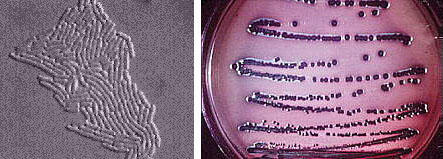TRANSMISSION OF INFECTION
Infection organisms always need to find a new host. Most human infections are acquired from other humans. This human- to- human transmission can occur through direct skin contact, for instance, shaking hands.
From our point of view sores, diarrhoea, and coughing are symptoms of disease. From a germ's point of view they are clever evolutionary strategies to broadcast the germ and ways of spreading. Those are common ways:
- to be eaten: Salmonella bacteria, which can be contract by eating already infected eggs or meat
- hitchhike in the saliva of an insect (mosquitoes, fleas, lice, tsetse flies) that bites the old host and flies to find a new one : Plague, malaria, typhus, sleeping seekness.
- from a woman to her fetus : syphilis, rubella, AIDS
- sores : smallpox, syphilis.
- to cough or sneeze in common cold and influenza, launching clouds of microbes toward new hosts.
- massive diarrhoea like cholera that delivers bacteria into water supplies.
It can also occur by breathing in infected droplets of air. Infections transmitted this way include influenza, chickenpox, measles, pneumonia and tuberculosis.
Some microorganisms are transmitted through contact with other body fluids, including blood, saliva, and mucus. This system includes HIV and hepatitis B, C and D.
Other common methods of transmission involve contamination of water (for example cholera and hepatitis A are transmitted this way). Transmission can also occur eating infected food that has been washed with infected water, handled by someone with infected hands or from contamination by insects or rodents.
A few infections are acquired when an infection in an animal jumps to a human being. This is the case for anthrax and rabies.
Animals can also act as disease vectors. In this case they do not suffer from the disease but carry it with them and are capable of infecting humans. Mosquitoes, lice and fleas commonly carry microbes that can cause serious infection.
Many pathogens are present in the environment and require only the opportunity to enter the body to produce disease. For example, tetanus is produced by the bacterium Clostridium tetani, which is present in the soil. When the tetanus pathogen enters the body through a cut or puncture in the skin, it grows rapidly in the deepest parts of the wound, causing fever, muscles spasms, and sometimes death.Infections can be endemics (constantly present in a population) or occur in epidemic (infecting large numbers of people before disappearing) that spreads rapidly through the population.
